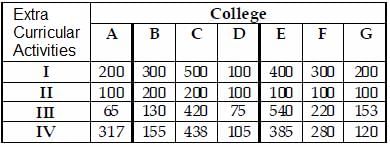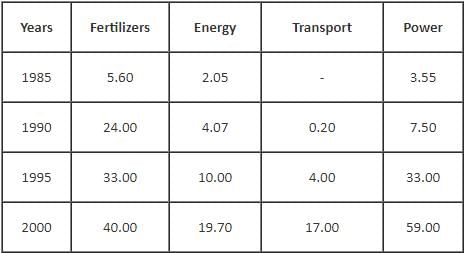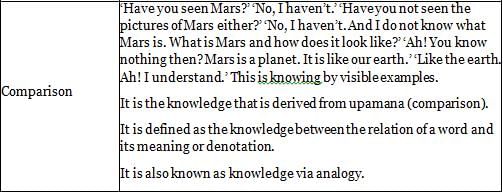MH SET Paper 1 Mock Test - 4 - MAHA TET MCQ
30 Questions MCQ Test - MH SET Paper 1 Mock Test - 4
Identify the advantages of LED Monitor:
- It includes a broader dimming range.
- It is a more reliable monitor.
- It is often less expensive.
- It consumes less power (20 watts), and run on a lower temperature.
- It has a more dynamic contrast ratio.
Choose the correct answer from the options given below:
Organisational communication can also be equated with
Direction: Study the following line graphs and answer the given questions.
The graph shows the ratio of marks of History to Geography of 7 students in an examination.

Q. Percentage increase of marks in Geography from student 3 to 4 is:
The graph shows the ratio of marks of History to Geography of 7 students in an examination.

Q. Percentage increase of marks in Geography from student 3 to 4 is:
Directions: Study the given graph carefully to answer the question that follows.
Number of people (in thousands) using three different types of mobile services over the years.

Q. The total number of people using all the three mobile services in the year 2007 is 'X' percent of the total number of people using all three mobile services in the year 2008. Find the value of 'X'.
Match List I with List II in order to make correct sentences.

Choose the correct answer from the options given below:
Which of the following set of statements reflects the basic characteristics of teaching?
(A) Teaching is related to learning.
(B) Teaching is a ‘task’ word while learning is an ‘achievement’ word.
(C) One may teach without learning taking place.
Direction: Study the following table chart carefully and answer the question given beside.
The following table represents the Maximum marks of five subjects and marks obtained by five students in five subjects.

Q. Find the respective ratio of the marks obtained by all the students in Mathematics and marks obtained by all the students in Chemistry.
Which of the following have the potential to trigger a tsunami?
1. Landslides
2. Volcanic eruptions
3. Glacial calving
4. Meteorite impact
Which of the following is not the function of Mass media?
If a cylinder has base radius of 6 cm and height 7 cm then find its volulme?
List I mentions the four valid means of knowledge as given by gotama while List II gives their description. Match List-I with List-II:

Choose the correct answer from the options given below:
System software is the set of programs that enables the computer’s hardware devices and _________ software to work together.
Which Telephonic Conferencing with a radio link is very popular throughout the world?
The statement - "We need to understand the importance of controlling our mind to tread the path that leads to Buddhahood" - is
Direction: Read the passage given below and answer the questions by choosing the correct/most appropriate options.
More than eight months after the national lockdown was announced in late March, urban India is learning to live with the Covid-I9 pandemic. In fact, indicating a positive outlook for the future, many survey respondents in a recent survey say they plan to return to pre-lockdown levels of shopping, personal grooming, going to cinemas and socializing as pandemic fears continue to recede.
The survey findings highlight that the suppression of consumer demand because of fears of job losses and salary cuts could be coming to an end. Increasingly, urban Indians are showing increased confidence about the future of the economy. This could be an indicator of the possible 'pent-up demand' that several economists have been talking about — a demand that could be unleashed once a vaccine is developed and distributed, or when there are signs of the pandemic's spread reducing to negligible levels or vanishing totally.
Around 65 per cent of respondents said they had settled into new routines, or that they saw signs of the situation improving, or they had come to terms with the pandemic and were moving on with their lives. And since the survey was conducted before the news of the successful trials of the Pfizer vaccine for the coronavirus was announced, it is likely that the consumers are now even more positive in their outlook about the future.
Q. Which statement in the passage/phrase indicates that 'Life must go on'?
The target set by the Indian government for generating power from wind energy by the year 2022 was
Match List I with List II

Choose the correct answer from the options given below:
The science of communication and control is known as
Direction: Given below are two statements.
Statement I: Preadolescent children are unable to think abstractly or hypothetically.
Statement II: In the formal operational stage a child is able to use symbols related to abstract concepts.
In light of the above statements, choose the most appropriate answer from the options given below:
Direction: Select the option that is related to the third word in the same way as the second word is related to the first word.
Biology : Science : : Political Science : ?
A lecture without feedback from the students is ______.
Direction: Read the following passage carefully and answer the questions.
The Draft National Education Policy, 2019 (DNEP) implements the India-centric education system, which contributes to the continuous transformation of our nation into a just and vibrant knowledge society, by providing high-quality education to all. The NITI Aayog has focused policy focus specifically on education and outcomes of education from programs. It has promoted competitive federalism among states to improve their educational indicators that are measurable by a battery of tests on students. But any serious work on 'No One Left Behind' (NOLB) can ask for a new and reformist approach. DNEP has provided some hope, but it calls for further examination of rhetoric and reality.
DNEP must be read in the context of the current economic and educational climate in order to estimate the path and speed needed to make its vision a reality. On the one hand, we are in another new era of industrial revolution or skilled age. On the other hand, at present, around one million youth enter the workforce in India each month, but most of them are just raw hands without professional technical knowledge or practical business skills. The weak relationship between education and employment poses a potential risk of turning India's demographic dividend into a demographic disaster.
In the education sector, the elusive chaos of the quantity-quality-equity triangle remains unresolved. Although the merits of education are well recognized as an invaluable public, public investment for this has been minimal. It is relevant to explore how DNEP has addressed some key areas for policy interventions in school education, namely access, which can be measured by the education system, the size and flow of students crossing over to equity, which can be seen development-deprived populations, and lack or persistence of quality, which can be understood by teaching-learning processes and developmental outcomes for children that are more easily implied by attainable scores.
Q. What calls for further examination of rhetoric and reality?
Directions: Study the given table and answer the following question.
The following table shows the number of students of 7 colleges participating in extra curricular activities:

Q. The college in which minimum number of students participate in extra curricular activities is
Directions: In making decisions about an important question, it is desirable to be able to distinguish between 'strong' arguments and 'weak' arguments. 'Strong' arguments are those which are both important and directly related to the question. 'Weak' arguments are those which are of minor importance and also may not be directly related to the question or may be related to a trivial aspect of the question.
The given question is followed by arguments numbered I and II. You have to decide which of the arguments is/are 'strong' argument(s) and which is/are 'weak' argument(s) and mark your answer accordingly.
Q. Should there be a silver bullet solution for the 'Kashmir problem'?
Arguments:
I. No, there is not just one Kashmir problem in the country, but many, and each requires redressal by divergent means and at different stages.
II. No, there is a set of disparate problems of governance and of a communal, polarising and disruptive politics, each demanding a separate solution.
Educational technology that has its origin in physical science and engineering:
a. Educational technology I
b. Educational Technology II
c. Hard approach
d. Soft approach
Select the correct answer from the code given below:
Direction: Read the passage carefully and answer the following question.
If the world is different today, we need to think, talk and engage accordingly. Falling back is unlikely to help, he said adding “purposeful pursuit of national interest is shifting global dynamics”. Highlighting India’s new approach in dealing with terrorism he compared “lack of response to the terror attack in Mumbai in comparison to the way the country responded to the Uri and Pulwama strikes. On India walking away from the Regional Comprehensive Economic Partnership, the external affair minister said no agreement was better than having a bad agreement.
Giving a historical perspective to geopolitical issues, Jai-Shankar said “For years India’s position on the world state seemed assured but the 1962 conflict with China significantly damaged India’s standing.
Q.“For years India’s position on the world state seemed assured but the 1962 conflict with China significantly damaged India’s standing."
The above statement was given by:
Which one of the following belongs to the category of homogeneous data?
Directions: The question is based on the following table.
DEMAND FOR GAS (Million Cubic meters/day)

Q. From 1985 to 2000, which is the sector that has been experiencing roughly double the demand every five years?




















